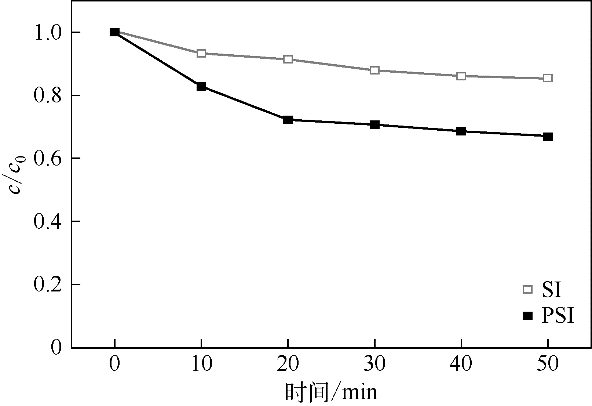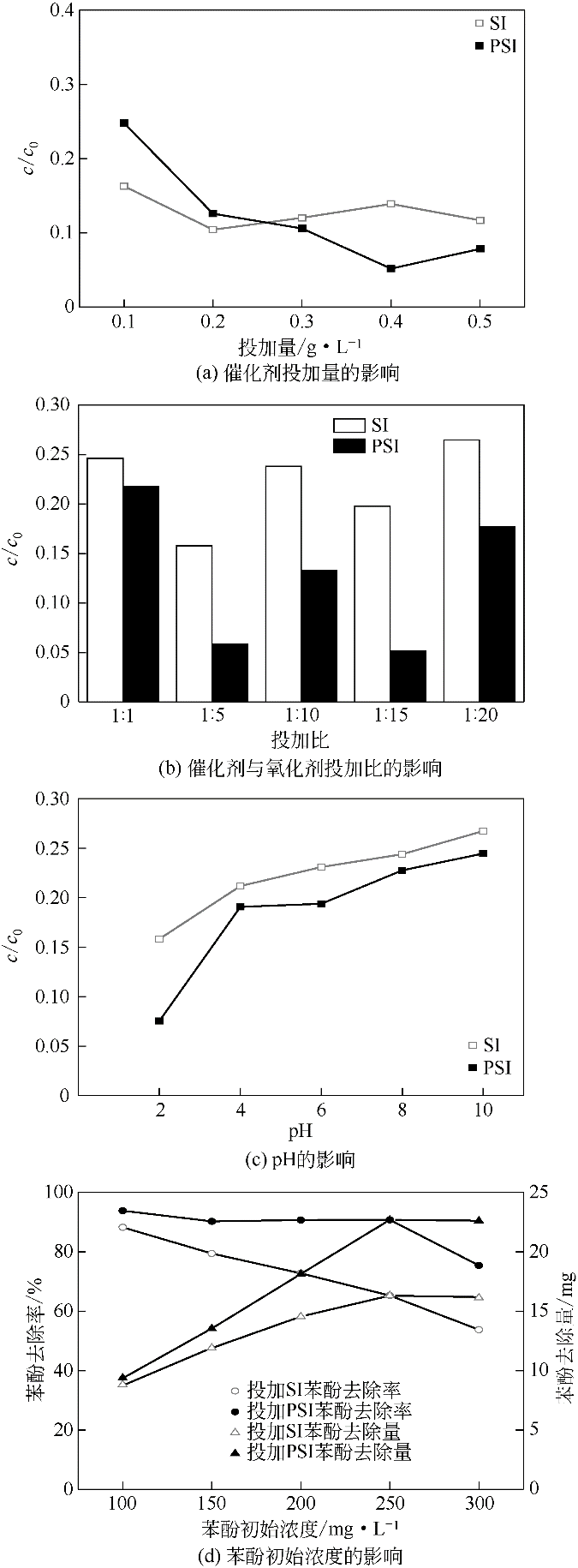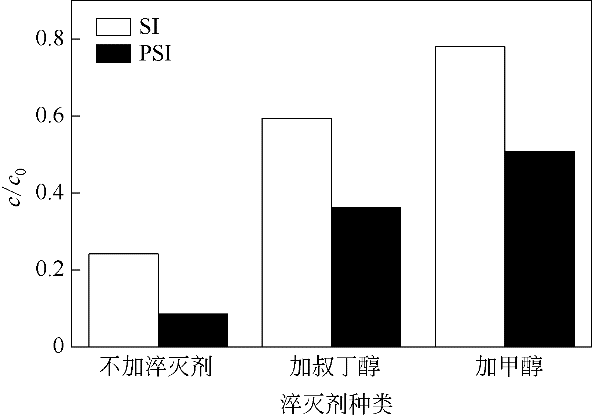Chemical Industry and Engineering Progress ›› 2020, Vol. 39 ›› Issue (2): 798-804.DOI: 10.16085/j.issn.1000-6613.2019-0810
• Resources and environmental engineering • Previous Articles Next Articles
Treatment of phenol wastewater with persulfate activated by plasmamodified sponge iron
Aihua CHENG( ),Wanchao MA,Zhe XU
),Wanchao MA,Zhe XU
- College of Geology and Environment, Xi’an University of Science and Technology, Xi’an 710054, Shaanxi, China
-
Received:2019-05-17Online:2020-03-12Published:2020-02-05 -
Contact:Aihua CHENG
等离子体改性海绵铁活化过硫酸盐处理含酚废水
- 西安科技大学地质与环境学院,陕西 西安 710054
-
通讯作者:程爱华 -
作者简介:程爱华(1977—),女,博士,副教授,硕士生导师,研究方向为水处理技术。E-mail:cah_cheng@126.com 。 -
基金资助:国家自然科学基金(51278418)
CLC Number:
Cite this article
Aihua CHENG,Wanchao MA,Zhe XU. Treatment of phenol wastewater with persulfate activated by plasmamodified sponge iron[J]. Chemical Industry and Engineering Progress, 2020, 39(2): 798-804.
程爱华,马万超,徐哲. 等离子体改性海绵铁活化过硫酸盐处理含酚废水[J]. 化工进展, 2020, 39(2): 798-804.
share this article
Add to citation manager EndNote|Ris|BibTeX
URL: https://hgjz.cip.com.cn/EN/10.16085/j.issn.1000-6613.2019-0810
| 催化剂 | 比表面积/m2·g-1 | 单点比表面积/m2·g-1 | 孔径/nm | 孔容/cm3·g-1 |
|---|---|---|---|---|
| SI | 1.04 | 0.44 | 37.25 | 0.10 |
| PSI | 1.41 | 1.11 | 55.51 | 0.20 |
| 催化剂 | 比表面积/m2·g-1 | 单点比表面积/m2·g-1 | 孔径/nm | 孔容/cm3·g-1 |
|---|---|---|---|---|
| SI | 1.04 | 0.44 | 37.25 | 0.10 |
| PSI | 1.41 | 1.11 | 55.51 | 0.20 |
| 1 | 刘晓红, 王芳, 王任震, 等. 核桃果皮基活性炭对苯酚吸附的热力学研究[J]. 安全与环境学报, 2015, 15(4): 236-239. |
| LIU X H, WANG F, WANG R Z, et al. On the thermodynamic principle for the walnut peel-activated carbon to adsorb phenol[J]. Journal of Safety and Environment, 2015, 15(4): 236-239. | |
| 2 | 黄浩鑫, 张会平, 鄢瑛. CuO/PSSF复合催化剂的制备及其在苯酚降解中的应用[J]. 化工进展, 2019, 38(3): 1377-1386. |
| HUANG H X, ZHANG H P, YAN Y. Synthesis of novel CuO/PSSF composite catalysts for the degradation of phenol[J]. Chemical Industry and Engineering Progress, 2019, 38(3): 1377-1386. | |
| 3 | 生活饮用水卫生标准: GB 5749—2006 [S]. 北京: 中国标准出版社, 2007. |
| Standards for drinking water quality : GB 5749—2006 [S]. Beijing: Standards Press of China, 2007. | |
| 4 | 刘欢, 陈灿, 邱德跃, 等. 络合萃取法处理含酚废水的研究[J]. 精细化工中间体, 2016, 46(3): 52-56. |
| LIU H, CHEN C, QIU D Y, et al. Treatment of wastewater containing phenols by complexation-extraction process[J]. Fine Chemical Intermediates, 2016, 46(3): 52-56. | |
| 5 | SANG C L, SUNKYU P. Removal of furan and phenolic compounds from simulated biomass hydrolysates by batch adsorption and continuous fixed-bed column adsorption methods[J]. Bioresource Technology, 2016, 216: 661-668. |
| 6 | 刘子乐, 曾泽泉, 杨洁杨, 等. 表面改性活性炭活化过硫酸盐降解苯酚[J]. 高等学校化学学报, 2017, 38(7): 1241-1248. |
| LIU Z L, ZENG Z Q, YANG J Y, et al. Degradation of phenol with persulfate activated by surface modified activated carbon[J]. Chemical Journal of Chinese Universities, 2017, 38(7): 1241-1248. | |
| 7 | 钱飞跃, 王翻翻, 刘小朋, 等. 碳质材料催化活化臭氧氧化去除水中溶解性有机物的研究进展[J]. 化工进展, 2015, 34(6): 1755-1761. |
| QIAN F Y, WANG F F, LIU X P, et al. Catalytic ozonation based on carbon materials for removing dissolved organic compounds from water: a review[J]. Chemical Industry and Engineering Progress, 2015, 34(6): 1755-1761. | |
| 8 | 师艳婷, 乔生莉, 张巧玲, 等. 磁性光催化剂Fe3O4/SiO2/TiO2的制备及光活化降解苯酚[J]. 化工进展, 2018, 37(11): 4322-4329. |
| SHI Y T, QIAO S L ZHANG Q L, et al. Preparation of Fe3O4/SiO2/TiO2 magnetic photocatalyst and the photo catalytic degradation of phenol[J]. Chemical Industry and Engineering Progress, 2018, 37(11): 4322-4329. | |
| 9 | ATHAR H, SHASHI K D, VINAY K. Kinetic study for aerobic treatment of phenolic wastewater[J]. Water Resources and Industry, 2015, 11: 81-90. |
| 10 | AHMAD M, TEELA L, WATTS R J. Mechanism of persulfate activation by phenols[J]. Environ. Sci. Technol., 2013, 47(11): 5864-5871. |
| 11 | LIU Y K, WANG S Y, WU Y L. Degradation of ibuprofen by thermally activated persulfate in soil systems[J]. Chemical Engineering Journal, 2019, 356(1): 799-810. |
| 12 | FANG Z, PAMELA C A, SHI Q. Degradation of naphthenic acid model compounds in aqueous solution by UV activated persulfate: influencing factors, kinetics and reaction mechanisms[J]. Chemosphere, 2018, 211(11): 271-277. |
| 13 | SANTOS A, FERMANDEZ J, RODRIGUEZ S. Abatement of chlorinated compounds in groundwater contaminated by HCH wastes using ISCO with alkali activated persulfate[J]. Science of the Total Environment, 2018, 615(2): 1070-1077. |
| 14 | KWONG K C, CHIM M M, DAVIES J F, et al. Importance of sulfate radical anion formation and chemistry in heterogeneous OH oxidation of sodium methyl sulfate, the smallest organosulfate[J]. Atmospheric Chemistry and Physics, 2018, 18(4): 2809-2820. |
| 15 | GAO F, LI Y J, XIANG B. Degradation of bisphenol A through transition metals activating persulfate process[J]. Ecotoxicology and Environmental Safety, 2018, 158: 239-247. |
| 16 | RODRIGUEZ S, VASQUEZ L, COSTA D, et al. Oxidation of Orange G by persulfate activated by Fe(Ⅱ), Fe(Ⅲ) and zero valent iron (ZVI)[J]. Chemosphere, 2014, 101: 86-92. |
| 17 | RAMA P, ROGGY D, SATINDER K B, et al. Activation of persulfate by homogeneous and heterogeneous iron catalyst to degrade chlortetracycline in aqueous solution[J]. Chemosphere, 2018, 207: 543-551. |
| 18 | 沈丽娜, 完颜华, 杨敏学, 等. 海绵铁预处理含酚废水的静态研究[J]. 兰州交通大学学报, 2004, 23(1): 61-64. |
| SHEN L N, WAN Y H, YANG M X, et al. Static study on pretreatment of phenol wastewater with spongy iron[J]. Lanzhou Jiaotong University, 2004, 23(1): 61-64. | |
| 19 | 刘贵, 宁平, 李凯, 等. 介质阻挡放电等离子体改性碳基材料研究进展[J]. 化工进展, 2015, 34(7): 1905-1912. |
| LIU G, NING P, LI K, et al. Research progress of dielectric barrier discharge plasma modification of carbon based materials[J]. Chemical Industry and Engineering Progress, 2015, 34(7): 1905-1912. | |
| 20 | AYMEN A A, SIVACHANDIRAN L, PHUONG N T, et al. Pilot scale degradation of mono and multi volatile organic compounds by surface discharge plasma/TiO2 reactor: investigation of competition and synergism[J]. Journal of Hazardous Materials, 2018, 357: 305-313. |
| 21 | ZHANG B, XU P, QIU Y, et al. Increasing oxygen functional groups of activated carbon with non-thermal plasma to enhance mercury removal efficiency for flue gases[J]. Chemical Engineering Journal, 2015, 263: 1-8. |
| 22 | WANG B F, CHEN B X, SUN Y H, et al. Effects of dielectric barrier discharge plasma on the catalytic activity of Pt/CeO2 catalysts[J]. Applied Catalysis B: Environmental, 2018, 238: 328-338. |
| 23 | TIAN J N, SHARAHAR M M, YANG M H, et al. Degradation of Rhodamine B at neutral pH using modified sponge iron as a heterogeneous electro-Fenton catalyst[J]. Environmental Progress & Sustainable Energy, 2018, 37(3): 989-995. |
| 24 | 万琼, 吴仪, 王信, 等. 基于固定化载体材料海绵铁净化微污染河水特性研究[J]. 化工进展, 2018, 37(5): 1999-2009. |
| WAN Q, WU Y, WANG X, et al. Study on the characteristics of the micro-pollution river purified by the immobilized carrier filler sponge iron[J]. Chemical Industry and Engineering Progress, 2018, 37(5): 1999-2009. | |
| 25 | ZHANG G L, DING Y B, NIE W S, et al. Efficient degradation of drug ibuprofen through catalytic activation of peroxymonosulfate by Fe3C embedded on carbon[J]. Journal of Environmental Sciences, 2019, 78: 1-12. |
| 26 | 杨岳, 黄碧纯, 叶代启. 低温等离子体对多孔材料的表面改性研究进展[J]. 化工进展, 2008, 27(11): 1760-1764. |
| YANG Y, HUANG B C, YE D Q. Surface modification of porous materials by non-thermal plasma[J]. Chemical Industry and Engineering Progress, 2008, 27(11): 1760-1764. | |
| 27 | YANG Y M, LENG Y Q, LIN X, et al. Degradation of Rhodamine B wastewater by persulfate activated with Fe3O4/graphene[J]. Environmental Science and Management, 2014, 39(4): 80-84. |
| 28 | 刘国强, 王斌楠, 廖云燕, 等. 热活化过硫酸盐降解水中的2-氯苯酚[J]. 环境化学, 2014, 33(8): 1396-1403. |
| LIU G Q, WANG B N, LIAO Y Y, et al. Degradation of o-chlorophenol by heat activated persulfate[J]. Environmental Chemistry, 2014, 33(8): 1396-1403. | |
| 29 | 马宁, 王亚娥, 李杰, 等. 新型水处理材料海绵铁在废水处理中的应用研究[J]. 环境科学与管理, 2014, 39(8): 71-73. |
| MA N, WANG Y E, LI J, et al. Application of new water treatment material sponge iron in wastewater treatment[J]. Environmental Science and Management, 2014, 39(8): 71-73. | |
| 30 | MATTHAIOU V, OUEGO P, FRONTISTIS Z, et al. Valorization of steel slag towards a Fenton-like catalyst for the degradation of paraben by activated persulfate[J]. Chemical Engineering Journal, 2019, 360: 728-739. |
| 31 | 刘佳露, 卢伟, 张凤君, 等. 活化过硫酸盐氧化地下水中苯酚的动力学研究[J]. 中国环境科学, 2015, 35(9): 2677-2681. |
| LIU J L, LU W, ZHANG F J, et al. Kinetics study of activated persulfate oxidation of phenol in ground water[J]. China Environmental Science, 2015, 35(9): 2677-2681. | |
| 32 | 朱思瑞, 高乃云, 鲁仙, 等. 热激活过硫酸盐氧化降解水中双酚A[J]. 中国环境科学, 2017, 37(1): 188-194. |
| ZHU S R, GAO N Y, LU X, et al. Degradation of bisphenol A in aqueous solution by thermally activated sulfate oxidation[J]. China Environmental Science, 2017, 37(1): 188-194. |
| [1] | CHENG Tao, CUI Ruili, SONG Junnan, ZHANG Tianqi, ZHANG Yunhe, LIANG Shijie, PU Shi. Analysis of impurity deposition and pressure drop increase mechanisms in residue hydrotreating unit [J]. Chemical Industry and Engineering Progress, 2023, 42(9): 4616-4627. |
| [2] | WANG Jingang, ZHANG Jianbo, TANG Xuejiao, LIU Jinpeng, JU Meiting. Research progress on modification of Cu-SSZ-13 catalyst for denitration of automobile exhaust gas [J]. Chemical Industry and Engineering Progress, 2023, 42(9): 4636-4648. |
| [3] | ZHANG Yaojie, ZHANG Chuanxiang, SUN Yue, ZENG Huihui, JIA Jianbo, JIANG Zhendong. Application of coal-based graphene quantum dots in supercapacitors [J]. Chemical Industry and Engineering Progress, 2023, 42(8): 4340-4350. |
| [4] | LI Yanling, ZHUO Zhen, CHI Liang, CHEN Xi, SUN Tanglei, LIU Peng, LEI Tingzhou. Research progress on preparation and application of nitrogen-doped biochar [J]. Chemical Industry and Engineering Progress, 2023, 42(7): 3720-3735. |
| [5] | GONG Pengcheng, YAN Qun, CHEN Jinfu, WEN Junyu, SU Xiaojie. Properties and mechanism of eriochrome black T degradation by carbon nanotube-cobalt ferrite composites activated persulfate [J]. Chemical Industry and Engineering Progress, 2023, 42(7): 3572-3581. |
| [6] | YANG Jiatian, TANG Jinming, LIANG Zirong, LI Yinhong, HU Huayu, CHEN Yuan. Preparation and application of novel starch-based super absorbent polymer dust suppressant [J]. Chemical Industry and Engineering Progress, 2023, 42(6): 3187-3196. |
| [7] | WANG Jiuheng, RONG Nai, LIU Kaiwei, HAN Long, SHUI Taotao, WU Yan, MU Zhengyong, LIAO Xuqing, MENG Wenjia. Enhanced CO2 capture performance and strength of cellulose-templated CaO-based pellets with steam reactivation [J]. Chemical Industry and Engineering Progress, 2023, 42(6): 3217-3225. |
| [8] | HE Chuan, WU Guoxun, LI Ang, ZHANG Fajie, BIAN Zijun, LU Chengzheng, WANG Lipeng, ZHAO Min. Characteristics of calcium and magnesium deactivation and regeneration of waste incineration SCR catalyst [J]. Chemical Industry and Engineering Progress, 2023, 42(5): 2413-2420. |
| [9] | YIN Ming, GUO Jin, PANG Jifeng, WU Pengfei, ZHENG Mingyuan. Deactivation mechanisms and stabilizing strategies for Cu based catalysts in reactions with hydrogen [J]. Chemical Industry and Engineering Progress, 2023, 42(4): 1860-1868. |
| [10] | CHEN Shaoqin, HU Ling, LEI Tianya, WANG Rong, SHU Jiancheng, CHEN Mengjun. Mechanical activation for zinc enhanced leaching from zinc calcine [J]. Chemical Industry and Engineering Progress, 2023, 42(3): 1649-1658. |
| [11] | CHEN Shaoyun, ZHOU Xiantai, JI Hongbing. Preparation of metalloporphyrin/carbon nanotube biomimetic catalysts and its catalytic mechanism in baeyer-villiger oxidation [J]. Chemical Industry and Engineering Progress, 2023, 42(3): 1332-1340. |
| [12] | CAO Min, MAO Yujiao, WANG Qianqian, LI Sha, YAN Xiaoliang. Sintering mechanism and sintering-resistant strategies for metal-based catalyst [J]. Chemical Industry and Engineering Progress, 2023, 42(2): 744-755. |
| [13] | LI Naizhen, SUN Ruijie, QIN Zhifeng, MIAO Maoqian, WU Qiongxiao, CHANG Liping, SUN Pengcheng, ZENG Jian, LIU Yi. Effects of constant carbon atmosphere on the activity, selectivity and coking of catalysts in hydrodesulfurization of coke oven gas [J]. Chemical Industry and Engineering Progress, 2023, 42(2): 783-793. |
| [14] | SUN Qianqian, LIU Zhen, LI Rui, ZHANG Xi, YANG Mingde, WU Yulong. Low temperature hydrothermal coupling of ferrous ion activated persulfate to improve the dewatering performance of waste activated sludge [J]. Chemical Industry and Engineering Progress, 2023, 42(2): 595-602. |
| [15] | DUAN Yihang, GAO Ningbo, QUAN Cui. Effect of hydrothermal treatment on pyrolysis characteristics and kinetics of oily sludge [J]. Chemical Industry and Engineering Progress, 2023, 42(2): 603-613. |
| Viewed | ||||||
|
Full text |
|
|||||
|
Abstract |
|
|||||





